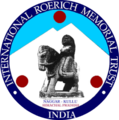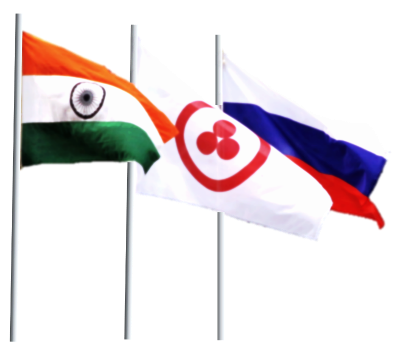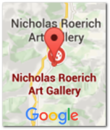29.04-01.05.2018
Indo-Russian Festival “The Roerichs’ Himalayan Estate – Karma-Bhumi of the Great Russian Family.”
Traditional Indo-Russian Spring Culture Festival celebrated on April 29-May 1, 2018 in the International Roerich Memorial Trust.
This year, the festival was dedicated to the 90th anniversary of the Roerichs’ arriving and settling in Kullu and was called “The Roerichs’ Himalayan Estate – Karma-Bhumi of the Great Russian Family.”Karma-bhumi is an ancient Sanskrit word meaning the place where one is destined to perform one’s duty, the place of toil, great accomplishments and spiritual achievements. Nicholas Roerich, his spouse Helena Roerich and their sons, George and Svetoslav Roerich, spent around 20 years in the Kullu Valley. Here they founded ‘Urusvati’ Himalayan Research Institute, drafted the Roerich Pact, created beautiful canvases and recorded the texts of the philosophical teaching of the Living Ethics. Here the foundations of Indo-Russian friendship and cultural cooperation were laid. Verily, the Estate in Naggar became the karma-bhumi for the Roerichs.
The esteemed guests of the programme were H.E. Mr. Nikolay Kudashev, Ambassador of the Russian Federation to the Republic of India and his spouse; Mrs. Nana Mgeladze, Counsellor (Culture), Embassy of the Russian Federation in the Republic of India; Mr. Akshay Sood, Additional District Magistrate; Dr. Amit Guleria, Subdivisional Magistrate, Kullu; Mr. Sunny Sharma, Assistant Commissioner to District Commissioner, Kullu; Mrs. Natalia Cherkashina, Acting Director, Museum Named After Nicholas Roerich managed by the International Centre of the Roerichs (ICR), Moscow; Ashok Thakur, Life Trustee, IRMT; and Mrs. Sushma Sharma, Pradhan, Naggar Panchayat.
The Festival was inaugurated by Mrs. Larisa Surgina, Russian Curator, IRMT, who invited the esteemed guests on the stage of the Green Theater for the lamp-lighting ceremony and receiving traditional gifts. H.E. Mr. Nikolay Kudashev, Ambassador of the Russian Federation to the Republic of India offered his welcome address to the gathering. Mr. Kudashev has already visited the Roerich Estate a number of times, but it was his first visit as Russian Ambassador. Mrs. Nana Mgeladze, Counsellor (Culture), Embassy of the Russian Federation in the Republic of India, stressed the importance of the IRMT as the center of Indo-Russian cultural cooperation. Taking floor on behalf of the Kullu District administration, the Subdivisional Magistrate Dr. Amit Guleria welcomed the guests and noted that the Roerich Estate was a veritable pearl of Himachal Pradesh and wished the Festival full success. On behalf of ICR, Moscow, Mrs. Natalia Cherkashina greeted the Festival participants and presented the IRMT with the English version of the book by Mrs. Lyudmila Shaposhnikova Scholar, Thinker, Artist. In his address, Mr. Tsering Dorje spoke of the ‘Urusvati’ Himalayan Research Institute expeditions to Lahaul. All those who took floor spoke of the eternal significance of the Roerichs’ creative work and the necessity of developing the IRMT into a world class museum and research center.
Ms. Sunita Bali, Designer with the Ministry of Textiles, Government of India, displayed an attractive selection of Indian decorative and applied art. Ms. Bali successfully combines in her creations the traditional Kullu motifs and contemporary trends in textile design. The colourfully decorated garments, handbags, purses and other items designed by her excited the lively and sincere interest of the guests.
Close because during the preparation for the competition despite the language barrier Indian children and youth with great pleasure listened to the stories about Russia and played Russian games; and also because the Roerich Estate in Naggar is a piece of Russia in India, with which all residents of Kullu, old and young, are connected in one way or another.
Inauguration of the painting exhibition “India Through the Eyes of Russian Children and Youth” and the painting competition “Russia Through the Eyes of Indian Children and Youth” became the main events of the first day of the Festival. Both, the exhibition and the competition were held within the framework of the Children and Youth Festival of Indo-Russian Friendship “Russia-India: From Heart to Heart,” which started last year and is dedicated to the 70th anniversary of Russian-Indian diplomatic relations. The Festival was initiated by the ICR volunteers headed by Mrs. Tamara Merges. With their active support, in the past half a year the exhibition of paintings by the children of Naggar and neighbouring villages called “Kullu – the Valley of Gods” has travelled to several cities of Russia. The exhibition inspired the creativity of Russian children and youth, and the exhibition of the products of that creativity opened on the IRMT Green Theater ground on that day. The temples of India, her nature, elephants, men and mountains – vibrantly colourful, heartfelt, and imbued with the sense of fairy tale and dream, were offered to the attention of the audience. At the same venue, the Russian guests demonstrated the Russian applied folk art and gifted sushkas (dry ring-shaped crackers), lucky charms in the form of cloth dolls, and other mementos to all those present.
Mr. Vitaly Vassilyev, Director, St. Petersburg Center for Humanitarian Programs and organizer of the Russian plein air and exhibition project “Art Expedition-2018. The Himalayas” conducted on the IRMT territory in April 15-30, 2018, wished success to the participants of the competition. Mr. Vassilyev passed the creativity torch, as it were, from the established professional Russian artists to the budding young artists of India whose best paintings will be sent to Russia to carry on the work of strengthening the heartfelt bonds of friendship between the two nations.
The holy Shanti Puja – the prayer for peace and welfare, which took place, in accordance with tradition, under the four-trunked Himalayan pine nearby Roerich House where the stone images of the Gods and Protectors of the Kullu Valley collected by the Roerichs are placed – became a truly international event.
The inauguration of the exhibition of the results of the Art Expedition took place on May 1 and became one of the main events of the Festival. Inspired by the beauty of the Himalayas and the unique atmosphere of the Roerich Estate the participants of the plein air project created remarkable canvases in which they depicted memorial sites of the Roerichs as well as landscapes of the Kullu Valley, its monasteries, temples and traditions, i.e. the cultural-historical milieu that surrounded Nicholas Reorich and his family and which they deeply respected and carefully studied. The artists solemnly presented to the IRMT all the displayed paintings.
The participants of the Art Expedition -2018 made yet another wonderful gift to the IRMT. At the request of the IRMT Curators, they painted a schematic map of the major expeditions of ‘Urusvati’ Himalayan Research Institute on the walls of the internal staircase of the Administrative Building of the Institute. The artists that executed the design of the historic staircase were the Belorussian-Indian couple Natalia Bogushevich and Nand Kishor Sharma residing in Rajasthan who took part in the project “Art Expedition-2018. The Himalayas.”
The exhibition of the Nasik-based Marathi artist Shiv Kumar became a great gift to the guests and participants of the Festival. Shiv Kumar can be easily called the master of watercolours – the medium he prefers to all others and which helps him to express on paper his innermost feelings. “I try to feel and experience every landscape I attempt to depict,” says Shiv Kumar, “The feeling of landscape is impossible to express in words, only in brushstrokes.” “A painting should touch human heart...” adds the artist.
Shiv Kumar’s watercolours conjure the extremely touching images of Maharashtrian countryside and the views of his native town with its narrow streets, temples and marketplaces with their clustering shops. He also paid tribute to the region’s rich cultural heritage displaying his depictions of ancient Buddhist caves and the Aurangzeb-built Khultabad Fort with its stupendous walls and massive gates. Among the displayed pieces one could see several views of Naggar (including its landmark: Tripura Sundari Temple). The artist likes to work in morning hours when nature is bathed in the rays of rising sun and he succeeds in capturing in his landscapes this joyful morning sunlight. And as one of the visitors of the exhibition rightly observed, “Shiv Kumar’s works are saturated with love of nature and marked by high professionalism.”
Within the framework of the Festival was also held the academic seminar “The Roerichs in Kullu: Many Aspects of Creativity” dedicated to the various activities of all the members of the Roerich family. The seminar was attended by the scholars and researchers from India, Russia and Estonia.
The cultural programme by the teachers and students of the Helena Roerich Academy of Arts for Children and Russian volunteers became a real treat for the Festival guests. The venue resounded with the slow, gay, lyrical and joyful tunes of the Indian and Russian folk songs. And during the collective performance of the everyone’s favourite “Katyusha” or “Rastsvetali” (Russian for “Were blooming,” the opening word of the song), as Indian children call it, no one could tell the Russian voices from the Indian ones as they merged together in a single expression of joy, inspiration, friendship and mutual understanding. It was this atmosphere of creative cooperation that decided the success of the spring culture festival in the Himalayan Roerich Estate – the Karma-Bhumi of the great Russian family.

The esteemed guests took part in the ceremony of hoisting the Russian and Indian national flags and the Banner of Peace. The ceremony was also attended by the Pangang Monastery lamas, volunteers from ICR coming from various cities of Russia, the Tibetan Buddhist scholar Tsering Dorje, and a considerable number of guests from Russia, India, France, Estonia and other countries.














The programme at the IRMT Green Theater continued with the children’s painting competition. In their works, the young artists of the Helena Roerich Academy of Arts for Children and Kullu Valley schools attempted to show their own vision of Russia – at once distant and close.



































